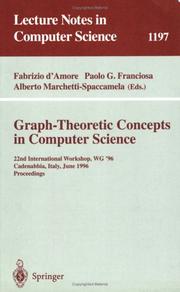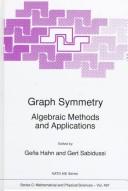| Listing 1 - 2 of 2 |
Sort by
|

ISBN: 3540625593 3540680721 9783540625599 Year: 1997 Volume: 1197 Publisher: Berlin, Heidelberg : Springer Berlin Heidelberg : Imprint: Springer,
Abstract | Keywords | Export | Availability | Bookmark
 Loading...
Loading...Choose an application
- Reference Manager
- EndNote
- RefWorks (Direct export to RefWorks)
This book constitutes the carefully refereed post-proceedings of the 22nd International Workshop on Graph-Theoretic Concepts in Computer Science, WG '96, held in Cadenabbia, Italy, in June 1996. The 30 revised full papers presented in the volume were selected from a total of 65 submissions. This collection documents the state of the art in the area. Among the topics addressed are graph algorithms, graph rewriting, hypergraphs, graph drawing, networking, approximation and optimization, trees, graph computation, and others.
Algorithmes --- Graphes, Theorie des --- Informatique --- Computer science. --- Data structures (Computer science). --- Computers. --- Algorithms. --- Computer graphics. --- Applied mathematics. --- Engineering mathematics. --- Computer Science. --- Theory of Computation. --- Applications of Mathematics. --- Algorithm Analysis and Problem Complexity. --- Computation by Abstract Devices. --- Data Structures. --- Computer Graphics. --- Engineering --- Engineering analysis --- Automatic drafting --- Graphic data processing --- Graphics, Computer --- Algorism --- Automatic computers --- Automatic data processors --- Computer hardware --- Computing machines (Computers) --- Electronic brains --- Electronic calculating-machines --- Electronic computers --- Hardware, Computer --- Information structures (Computer science) --- Structures, Data (Computer science) --- Structures, Information (Computer science) --- Informatics --- Mathematics --- Computer science --- Congresses --- Graph theory --- Information theory. --- Mathematics. --- Computer software. --- Data structures (Computer scienc. --- Computer art --- Graphic arts --- Electronic data processing --- Engineering graphics --- Image processing --- Science --- Software, Computer --- Computer systems --- Math --- Communication theory --- Communication --- Cybernetics --- Digital techniques --- File organization (Computer science) --- Abstract data types (Computer science) --- Algebra --- Arithmetic --- Mathematical analysis --- Machine theory --- Calculators --- Cyberspace --- Foundations --- Algorithmes - Congres. --- Graphes, Theorie des - Informatique - Congres.

ISBN: 0792346688 9048148855 9401589372 9780792346685 Year: 1997 Volume: 497 Publisher: Dordrecht : Kluwer,
Abstract | Keywords | Export | Availability | Bookmark
 Loading...
Loading...Choose an application
- Reference Manager
- EndNote
- RefWorks (Direct export to RefWorks)
The last decade has seen two parallel developments, one in computer science, the other in mathematics, both dealing with the same kind of combinatorial structures: networks with strong symmetry properties or, in graph-theoretical language, vertex-transitive graphs, in particular their prototypical examples, Cayley graphs. In the design of large interconnection networks it was realised that many of the most fre quently used models for such networks are Cayley graphs of various well-known groups. This has spawned a considerable amount of activity in the study of the combinatorial properties of such graphs. A number of symposia and congresses (such as the bi-annual IWIN, starting in 1991) bear witness to the interest of the computer science community in this subject. On the mathematical side, and independently of any interest in applications, progress in group theory has made it possible to make a realistic attempt at a complete description of vertex-transitive graphs. The classification of the finite simple groups has played an important role in this respect.
Cayley graphs --- Group theory --- Congresses --- Discrete mathematics. --- Computer science—Mathematics. --- Group theory. --- Computer communication systems. --- Combinatorics. --- Microprocessors. --- Discrete Mathematics. --- Discrete Mathematics in Computer Science. --- Group Theory and Generalizations. --- Computer Communication Networks. --- Processor Architectures. --- Minicomputers --- Combinatorics --- Algebra --- Mathematical analysis --- Communication systems, Computer --- Computer communication systems --- Data networks, Computer --- ECNs (Electronic communication networks) --- Electronic communication networks --- Networks, Computer --- Teleprocessing networks --- Data transmission systems --- Digital communications --- Electronic systems --- Information networks --- Telecommunication --- Cyberinfrastructure --- Electronic data processing --- Network computers --- Groups, Theory of --- Substitutions (Mathematics) --- Discrete mathematical structures --- Mathematical structures, Discrete --- Structures, Discrete mathematical --- Numerical analysis --- Distributed processing --- Cayley graphs. --- Cayley color graphs --- Cayley color groups --- Cayley diagrams --- Cayley's color graphs --- Cayley's color groups --- Cayley's diagrams --- Cayley's graphs --- Color graphs, Cayley --- Color groups, Cayley --- Dehnsche Gruppenbild --- Diagrams, Cayley --- Gruppenbild, Dehnsche --- Graph theory --- Graphes, Théorie des
| Listing 1 - 2 of 2 |
Sort by
|

 Search
Search Feedback
Feedback About UniCat
About UniCat  Help
Help News
News